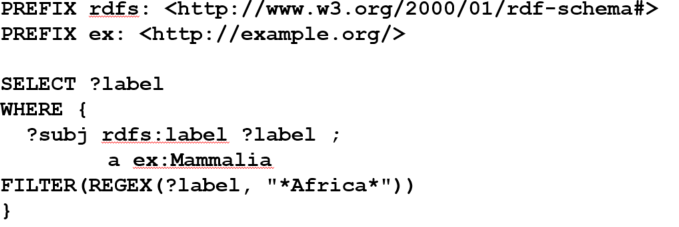SPARQL is an acronym for SPARQL Protocol and RDF Query Language
•SPARQL 1.1. became a W3C recommendation in March 2013: http://www.w3.org/TR/sparql11-overview/
•The spec covers the query language, the REST protocol for interaction with a SPARQL endpoint, and the result format (XML, JSON, CSV, TSV).
•The query language is about graph pattern matching with a syntax that resembles Turtle meets SQL. 查询语言是关于图形模式匹配,其语法类似于海龟遇到的SQL。
•Unlike SQL, you can query for unknown relationships, as you do not need to specify the Subject, Predicate and Object. You can use variables, in each position 与SQL不同,您可以查询未知的关系,因为您不需要指定主题、谓词和对象。您可以在每个位置使用变量
Example
SELECT * WHERE {?s ?p ?o }
In this valid SPARQL statement, the variables are identified by a “?” prefix, Inside the WHERE clause you can see the graph pattern, here an arbitrary triple.
Example

In this more typical SPARQL query, you can see variables, the use of prefixes, more Turtle syntax, and regular expression filtering.
Further SPARQL learning
ACTION: If you wish to learn more about SPARQL,Go to ~~[https://www.cambridgesemantics.com/blog/semantic-university/learn-sparql/sparql-by-example/~~](https://www.cambridgesemantics.com/blog/semantic-university/learn-sparql/sparql-by-example/)~~ You can see the lower left for navigation instructions and use arrow keys to move about. You will need to ignore the various Apollo-related “solutions” interspersed in the slides. Just go up to the end of Query#4. Read and think carefully as you go through. This will take 15-20 minutes. You may continue the tutorial at a later time if you wish, but there are errors in the tutorial as you go further.~~

